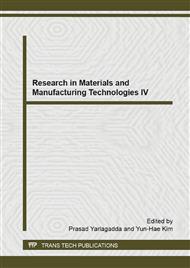p.575
p.579
p.584
p.588
p.592
p.596
p.601
p.605
p.609
Plasma Gear Manufacturing Thermal Aspects
Abstract:
The goal of the submitted paper is to provide information on gear production by means of non-conventional technology to rise production effectiveness. The work is aimed to innovative methods at production of spurs by means of assisting non-conventional technology of laser, plasma and water jet cutting. On the base of an analysis of material cutting, an optimal non-conventional technology for gear manufacturing was chosen, i.e. plasma cutting. The application of the mentioned technology influences a change of the structure of the cutting surface material, which has an impact on the cutting quality and following gear manufacturing processes. The intention of the experimental research was to look for elimination of thermal impact on structure of material used for gear manufacturing.
Info:
Periodical:
Pages:
592-595
Citation:
Online since:
December 2014
Authors:
Keywords:
Price:
Сopyright:
© 2015 Trans Tech Publications Ltd. All Rights Reserved
Share:
Citation:


